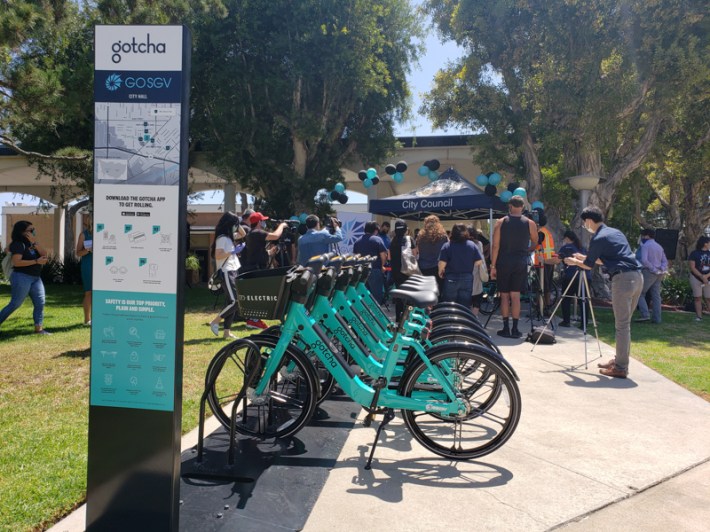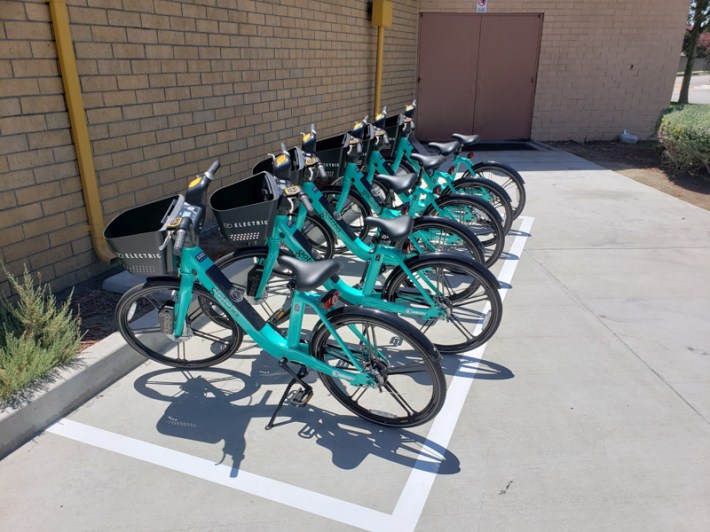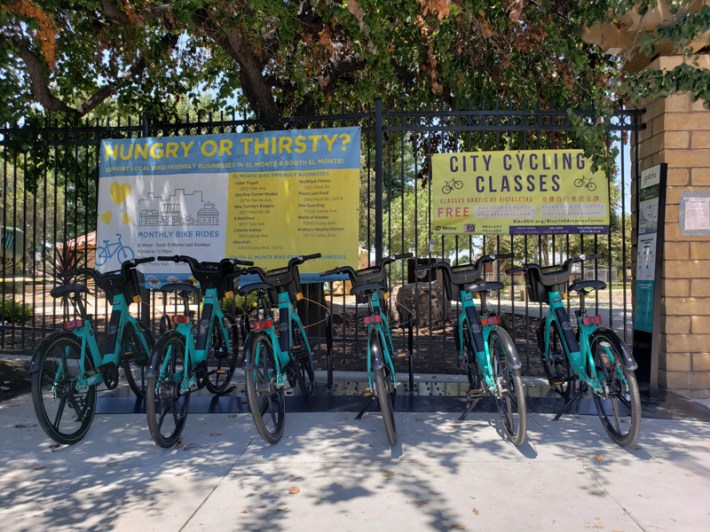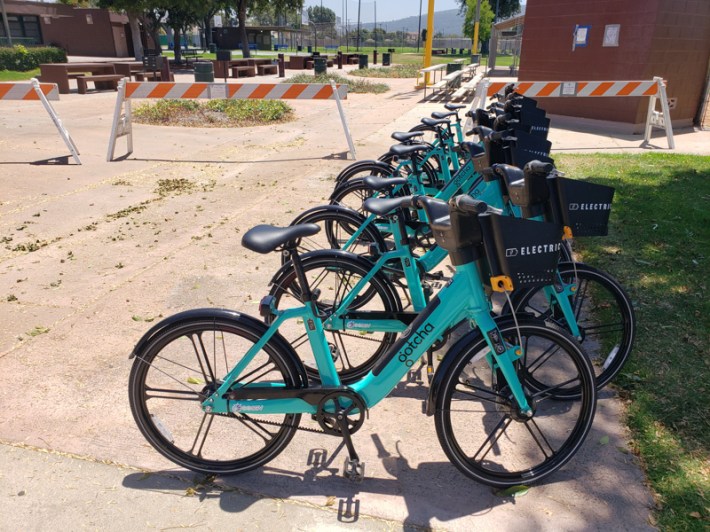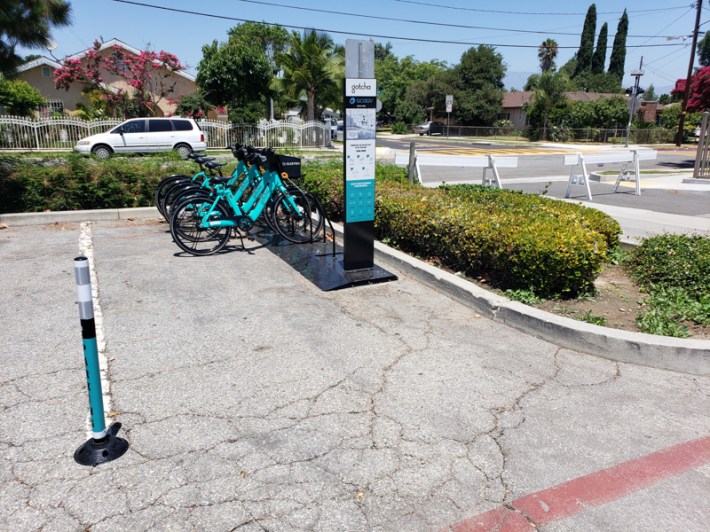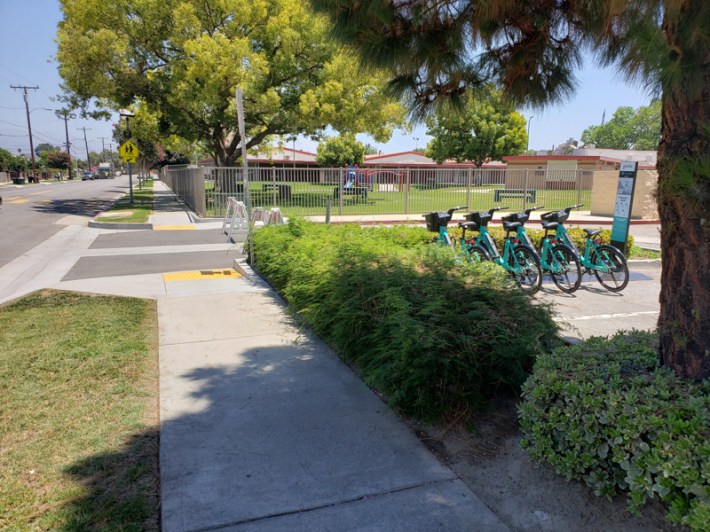Officials and the public gathered in front of South El Monte City Hall yesterday for a kick-off ceremony to launch GoSGV, the first planned multicity e-bike share program in the SGV.
South El Monte became the first city to host an e-bike share fleet in what will be a regional system stationed in half of San Gabriel Valley's 31 cities and unincorporated communities. Starting with an initial set of 35 bikes in South El Monte, GoSGV will expand over the next year to 840 bikes in Baldwin Park — which is the next city expected to receive bikes in the next couple months — El Monte, Covina, Claremont, Monterey Park, unincorporated areas of Los Angeles County and Cal Poly Pomona.
With a side street adjacent to city hall closed off, South El Monte City council members Manuel Acosta, Richard Angel and city manager Rachel Barbosa and others tested out the bikes.
"This bike is awesome! It just takes off," said Barbosa, as she passed the onlooking crowd.
GoSGV was made possible by a $4.554 million Greenhouse Gas Reduction Fund Grant awarded in 2017 by the California Transportation Commission to the San Gabriel Valley Council of Governments. The SGVCOG contracted Gotcha, a national private shared-mobility firm, last year to operate the system.
“The SGVCOG is delighted to be able to bring affordable and uniform bike-sharing to the San Gabriel Valley,” said La Verne Mayor Tim Hepburn, who serves as Third Vice President of the SGVCOG Governing Board. “Interest in bicycling has surged in recent months, with U.S. urban area ridership reported to have increased by 21 percent during the pandemic. Given this trend, we are prepared to further expand the number of bikes and are open to accepting additional San Gabriel Valley communities into the GoSGV program if demand supports it.”
Users can unlock bikes using the Gotcha app and will be charged $2 to unlock and 10 cents per minute to ride. Subscriptions of $79.99 annually or $9.99 monthly give 2o minutes of free ride time per unlock and 10 cents per minute after; a student and military discount would cost either $59.99 annually or $6.99 monthly.
A qualified low-income subscription is also being offered to riders. This subscription offers all the benefits of a regular annual plan, except the charge after the free 20-minute ride would cost 5 cents. The pay-as-you-go option would cost $1 to unlock and 5 cents per minute to ride.
The criteria to determine who qualifies for the low-income program is still being determined, said Benson Lam, Gotcha's operations manager for the SGV. People who qualify for social safety net programs like CalFresh, WIC, Southern California Edison CARE and Southern California Gas CARE may qualify for the low-income program, Lam said, but ultimately it's up to each GoSGV city to define that criteria.
A cashless option is currently being tested, but no definitive date is known on when that will be rolled out, Lam said.
Anyone using the system for the first time can use the promotion code SEM20 in the Gotcha app to waive the unlock fee.
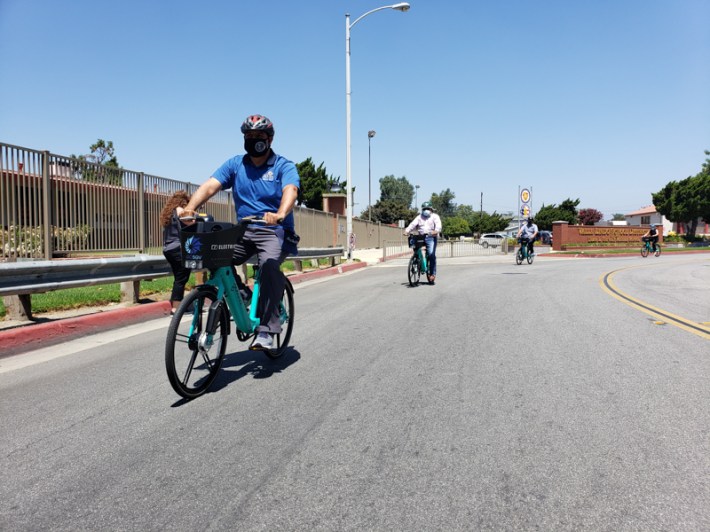
Gotcha is responsible for ensuring that e-bikes are maintained at stations and are taking steps to maintain their cleanliness in response to COVID-19. All bikes will be wiped down daily and handle tassels will be placed on the bikes reminding people to practice safe hygiene and to wash their hands after a ride, Lam said.
The system was initially expected to be rolled out last summer with a fleet of more than 1000 bikes. But a mixture of caution from participating cities about the program and supply impacts due to trade disputes between the U.S. and China caused the delay, said Caitlin Sims, principal management analyst at SGVCOG.
Gotcha has neared its fleet number goal with 600 e-bikes purchased, in storage and ready to be deployed in the SGV. The remaining cost of the program is covered by the bike rental fee, which pays for operating the system, Sims said.
SGVCOG staff is also working to bring the GoSGV to Duarte, La Verne, San Dimas, South Pasadena, and Pasadena, which previously had a bike share system through Metro that later was pulled from the city. But the conversations with those cities are at a much earlier phase, Sims said. While some of the cities have been slower in their response to GoSGV because they want to see how the system rolls out first, she said that she's encouraged that the regional scope of the program will help to assuage their doubts.
"Ultimately once it's built out there's a linkage throughout pretty much from east to west," Sims said. "Having that broader system beyond just a single city is going to help a lot."
Edward Duong, a community engagement specialist with Active SGV, was on hand for the unveiling. Duong said that he sees many benefits to GoSGV. It could help bridge first-last mile connections to transit, combat issues of obesity, and make biking more accessible to even the less experienced riders. "Hopefully this type of assist can help make healthier communities," Duong said.
Diane Velez, an Active SGV program specialist, said that it's encouraging to have this program, but now participating cities need to step up to support the system by improving sidewalks and adding more bike lanes. "We know the bikes came first, and so hopefully now we can move the infrastructure," Velez said.
Our San Gabriel Valley coverage, including this article and SGV Connect is supported by Foothill Transit, offering car-free travel throughout the San Gabriel Valley with connections to the new Gold Line Stations across the Foothills and Commuter Express lines traveling into the heart of downtown L.A. To plan your trip, visit Foothill Transit. “Foothill Transit. Going Good Places.”
Sign-up for our SGV Connect Newsletter, coming to your inbox on Fridays.
